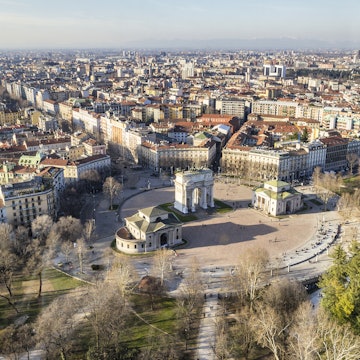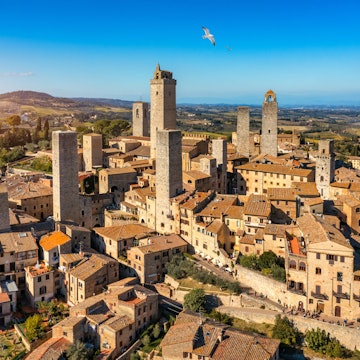

Near Naples, a range of islands, towns and historic sites – such as Sorrento – offer the chance to unwind and discover. ©Ellen van Bodegom/Getty Images
With its buzzing street life, fascinating neighborhoods and exhilarating sea views, Naples serves up plenty of things to see and do. But the pace of life in the city is full throttle, to say the least. Taking your foot off the pedal by setting out on a day trip from Naples promises a breath of fresh air.
Within a few hours, you could be on the Amalfi Coast or relaxing on a Gulf of Naples island – ticking some of Italy’s most enticing sights off your bucket list in the process. The top day trips from Naples cover a huge range of interests, from hiking, boating and swimming to archeology, architecture and Italian beach glamor. Day tripping also provides a precious opportunity to dig deep into the rich history of the Campania region, its Roman heritage and authentic island culture.
Read on for our list of the most alluring day trips from Naples.

1. Visit Campi Flegrei to explore volcanic hillsides and Roman ruins
Travel time: 45 minutes by metro or train, 30 minutes by car
Just west of Naples, the city’s best-kept secret is the unsung collection of bubbling mud pits and steaming fumaroles known as Campi Flegrei (the Phlegrean Fields). Scattered across this cinematic geothermal landscape are several Greco-Roman ruins that make for a highly rewarding day of exploring.
Wander through remarkably preserved underground passageways at the Flavian Amphitheater in Pozzuoli, seek out the chamber inhabited by Aeneid’s oracle amid Greek ruins in Cuma, and imagine Roman emperors soaking in the lavishly decorated thermal baths in the Roman seaside resort of Baia. Arrive early to squeeze in some snorkeling, diving or a glass-bottom boat trip to see Baia’s underwater archeological area.
How to get to Campi Flegrei from Naples:
The Flavian Amphitheater sites in Pozzuoli can be reached on Line 2 of the Naples Metro or via the Cumana railway. The rest of the Campi Flegrei area is spread out and not well served by public transport; fixed-rate taxi fares are available for Baia and Cuma. You can also drive your own rental car.

2. Hike Mt Vesuvius: mainland Europe’s only active volcano
Travel time: 1 hour 20 minutes by train and bus
An early-morning hike up Mt Vesuvius is one of Italy’s great adventures. Since exploding into history in 79 CE (when it buried the nearby towns of Pompeii and Herculaneum in pumice), Vesuvius has blown its top more than 30 times, most recently in 1944.
Anyone with a reasonable fitness level – including kids – can manage the steep 30-minute ascent from the parking lot to the ash-dusted crater rim. Rewarding your exertion, the bird’s-eye views from the summit of the city and bay of Naples are unforgettable.
Make a day of it by uncovering local flora and fauna on one of the nine marked walking paths that wind through the surrounding Parco Nazionale del Vesuvio (Vesuvius National Park). The best summit hike for seasoned walkers is the moderately difficult 3.8km (2.3mi) Gran Cono trail.
How to get to Mt Vesuvius from Naples:
From Naples take the Circumvesuviana or seasonal Campania Express train (30 to 35 minutes) to the Pompeii–Villa dei Misteri stop, then jump on a public EAV bus to the Vesuvius summit car park (around 50 minutes).

3. Explore Europe’s most compelling archaeological sites at Pompeii and Herculaneum
Travel time: 35 minutes (Pompeii) and 15 minutes (Herculaneum) by train
Few archaeological sites offer such an intimate connection to the past, or such a chilling trip back in time, as the mammoth UNESCO World Heritage–listed ruins of Pompeii. The destructive menace that is Mt Vesuvius buried the Roman town in volcanic ash and debris in 79 CE, and parts of the city are still being excavated to this day.
Elevated stepping stones once allowed prosperous Pompeiians to stroll along the elegant main street without getting their shoes covered in muck – and you can follow the same stones today, a surreal experience (and something kids will love).
To understand the complete story, pair your Pompeii visit with a dig around its frozen-in-time twin Herculaneum, hit by the same Vesuvius eruption. Home today to a fishing village of 4000 inhabitants, the site is smaller and less overwhelming than Pompeii, allowing you to visit without the nagging feeling that you may have missed a crucial ruin or carbonized fresco.
How to get to Pompeii and Herculaneum from Naples:
From Naples take the Circumvesuviana or seasonal Campania Express train to the Pompeii–Villa dei Misteri stop (30 to 35 minutes). The same train stops at Ercolano–Scavi train station (15 minutes from Naples and 30 minutes from Pompeii); from here, it’s a 500m (0.3mi) walk downhill along Via 4 Novembre to Herculaneum’s scavi (ruins).

4. Take a train to Sorrento on the beautiful Amalfi coast
Travel time: 70 minutes by train, 20 minutes by hydrofoil
An essential stop on every Grand Tour in the 19th century – and a favorite hobnobbing spot for the likes of Byron, Dickens and Tolstoy – this romantic town on the Amalfi Coast has lost none of its old-world charm. Head here early and devote the morning to meandering cobbled shopping alleys of the old town, awash with independent boutiques and artisan studios selling handcrafted leather goods, ceramics, tangy limoncello (lemon liqueur) and crafts made from Sorrento’s world-famous inlaid wood.
After lunch, wander around cloistered Chiesa di San Francesco and take in huge sea views from Villa Comunale park atop the town’s famous cliffs. From here, it’s a swift elevator ride down to Marina Piccola with its pebbly beach clubs. Alternatively, stroll to a deck-chair-speckled jetty to flop in the sun in quieter Marina Grande. A spritz aperitivo before departure at popular people-watching haunt Fauno Bar is simply non-negotiable.
How to get to Sorrento from Naples:
Sorrento is the last stop on the Circumvesuviana rail line from Naples. Trains run every 30 minutes from Naples (70 minutes), with stops in Pompeii and Ercolano (for Herculaneum). Sailing time on the hydrofoils that run year-round from Naples is around 20 minutes.

5. Travel to Capri for beautiful beaches and sweeping views
Travel time: Up to 75 minutes by boat
If you can tolerate the high-season crowds, a summertime visit to Naples’ most beautiful island will knock your socks off. If you don’t love crowds, we recommend visiting in spring or early fall for a calmer experience. Whenever you come, there are enough temptations to fill several days here if you have the time to spare.
Float on the luminous azure waters of the uber-touristed Grotta Azzurra, and glide to the island’s summit on the Monte Solaro chairlift to swoon over sublime views over the surrounding waters. Visit Axel Munthe’s eclectic Villa San Michele for more enchanting vistas, relive erstwhile poetic glories in art-nouveau Villa Lysis, or escape to Giardini di Augusto (Gardens of Augustus) for views over the dramatic Faraglioni rocks. At lunchtime, dining with Italian A-listers at La Palette or sophisticated Il Geranio is a Capri rite of passage.
How to get to Capri from Naples:
Board a high-speed hydrofoil (40 minutes) from Naples’ Molo Beverello port to Capri’s Marina Grande, or take the slower, more scenic island ferry (75 minutes) from Naples’ Porta di Massa.

6. Visit Ischia to relax on the beach or soak in bubbling thermal springs
Travel time: 45 minutes by hydrofoil
A short boat ride from Naples is the rocky outcrop of Ischia, the bay’s largest island, which is guarded by the looming mass of 789m (2589ft) Monte Epomeo. Chestnut forests, vineyards and volcanic-rock formations fill in the interior, while luxury thermal spas, manicured gardens and private beach clubs lace the busy coastline. The town of Ischia Porto has the best choice of bars and restaurants.
On the less-frenzied south coast, grab a water taxi from car-free Sant’Angelo to secluded Baia di Sorgeto, where hot – and free-to-access – thermal waters spill into rock pools. Pick a spot with the optimum temperature (the water can be scalding in places), then lie back on a rock and chill. Back in Ischia Porto, visit Castello Aragonese and stroll along boutique-lined Corso Vittoria Colonna before hopping on the last ferry back to Naples.
How to get to Ischia from Naples:
High-speed hydrofoils (45 minutes) run to Ischia’s main ferry terminal in Ischia Porto from Naples’ Molo Beverello port

7. Visit Reggia di Caserta: Italy’s version of Versailles
Travel time: 50 minutes by train
No royal palace in Italy dazzles quite like the baroque beauty that is UNESCO-listed Reggia di Caserta. The palace was founded in 1752 by Bourbon King Charles VII, who demanded a palace to upstage Versailles in France. And he got one: a mirage-like, 250m-long (820ft-long) cruise ship of a building, with 1200 rooms, 1790 windows and 34 staircases. According to local lore, it was the largest building in 18th-century Europe.
The admission fee covers a visit to the lavishly appointed royal apartments, Palatine chapel, royal court theater and a wonderful collection of traditional Neapolitan Christmas cribs. When you’re done with the interiors, come up for air with a jaunt through the palace’s equally sumptuous grounds, which can be explored on foot or by bus, bike or horse-drawn carriage. Don’t miss the English Garden, with its seductive Bath of Venus.
How to get to Caserta from Naples:
Regular trains link Naples with Caserta train station (50 minutes), from where it's a five-minute walk to the palace.
















